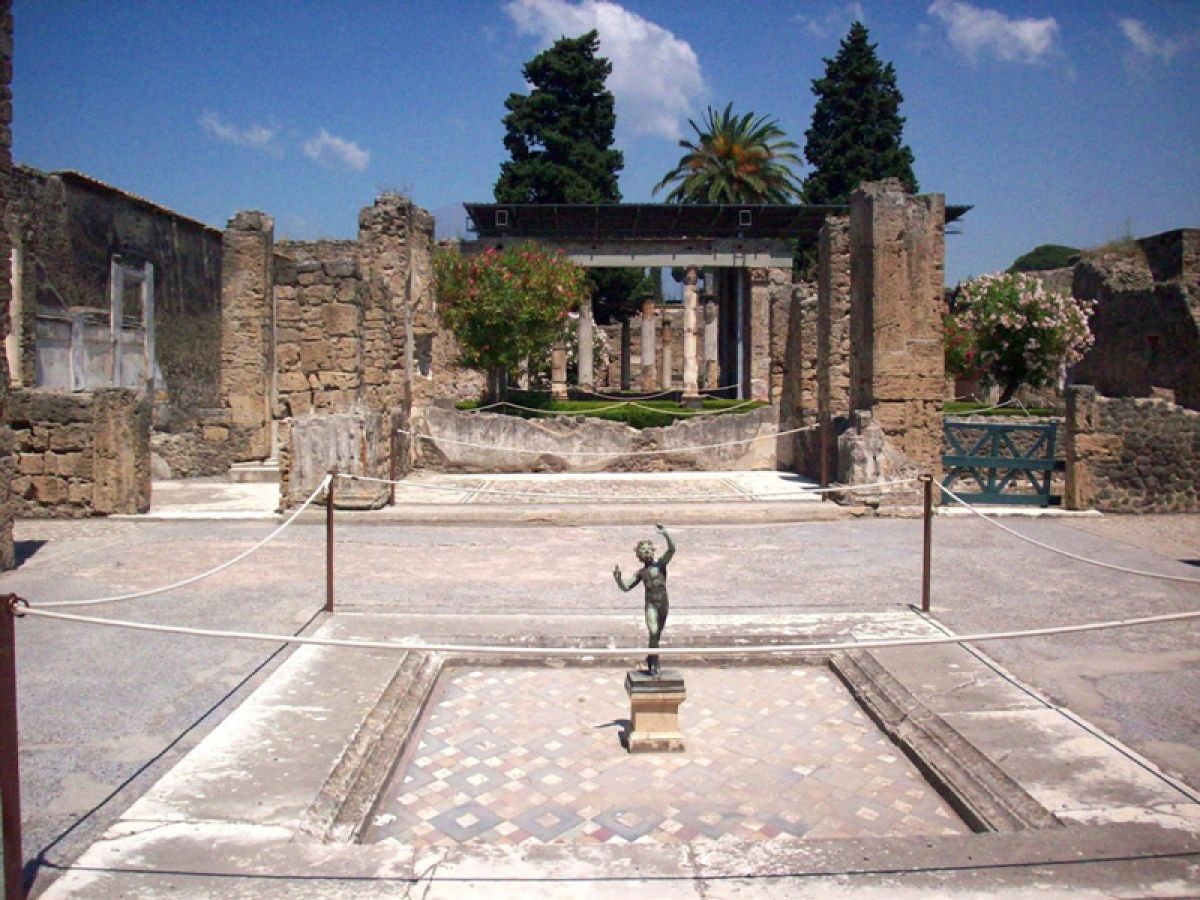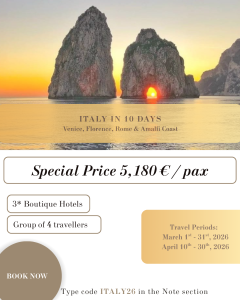ITALY IN 10 DAYS PRIVATE TOUR
Venice, Florence, Rome and the Amalfi Coast
From magic Venice to Florence, the cradle of Renaissance, then Rome, the Eternal City and finally the charming Amalfi Coast, to relax and enjoy stunning views! 10 days around Italy, to admire the extraordinary beauty of its most beautiful cities and be seduced by its enchanting landscape!!
HIGHLIGHTS
- Venice, when merchants ruled the Mediterranean
- Florence, an open-air museum
- Pisa, how can it stand?
- San Gimignano and Siena, power in the Middle Ages
- Val d’Orcia, where Man and Nature blend in harmony
- Orvieto, the city “on the rocks”
- Rome, walking in the shade of history
- The Vatican, Popes and power
- The Amalfi Coast, where divas are at home
- Pompei, the Roman city fixed in lava
WHAT’S INCLUDED
Overnights at 3* to 5* Hotels, Country Houses and Historical Palaces (when available), City Apartments along the itinerary
Transfers by private car / minivan / minibus / high-speed train (when available)
Activities:
- Day 1: 3-hour private walking tour of Venice city centre with an Authorised Tourist Guide – Admission to Saint Mark’s Basilica – Half-hour gondola ride
- Day 3: 3-hour private walking tour of Florence city centre with an Authorised Tourist Guide – Admission to Gallerie dell’Accademia (Michelangelo’s David) – Half-day excursion to Pisa – Admission to the Leaning Tower and other monuments in Piazza dei Miracoli
- Day 4: Full-day excursion to Siena and San Gimignano
- Day 5: Full-day excursion to Val d’Orcia area – 3-hour private walking tour of Montepulciano city centre with a Sommelier Guide, with tastings of Vino Nobile, Pecorino cheese and truffle – Visit of a Supertuscan Brunello di Montalcino wine cellar with tastings
- Day 6: 3-hour private walking tour of Imperial Rome with an Authorised Tourist Guide – Admission to the Colosseum and Imperial Fora Archeological Area
- Day 7: 3-hour private walking tour of the Vatican Museums with an Authorised Tourist Guide – Admission to the Vatican Museums with the Sistine Chapel
- Day 9: Full-day excursion of the Amalfi Coast: Amalfi, Ravello, Positano
- Day 10: 2-hour private walking tour of Pompeii Archeological Area with an Authorised Tourist Guide – Admission to Pompei Archeological Area
Customizations and Options
- Pick up at Venice Airport/ Venice Railway Station at the start of the tour
- Accommodation in Venice the night before the start of the tour
- Admission to Palazzo Ducale in Venice
- Stopovers in Modena and Maranello – Visit of a Balsamic Vinegar of Modena producer with tastings – Admission to Museo Ferrari in Maranello
- Admission to the Duomo Cathedral in Siena
- Admission to Saint Peter’s Basilica in Rome
- Roman Cooking Class in rome
- Drop off at Naples Airport/ Railway Station at the end of the tour
- Other activities upon request
Benvenuti in Italia, welcome to the “unique” Venice, the “city on the lagoon”!
You will be astonished by its beauty and charm!
You will start your visit with Piazza San Marco (St. Mark’s Square) and the Basilica interior, a 900-year-old marvel of architecture! The church is unique in Italy for its golden Byzantine and Medieval mosaics, intricate stone and marble traceries and exuberant Middle Eastern domes. Near St. Mark’s Basilica is Palazzo Ducale, the most impressive secular building in Venice and once the official residence of the supreme authority of Venice, the “Doge”. A masterpiece of Gothic architecture, the Doge’s Palace is an impressive structure composed of layers of building elements and ornamentation, from its 14th and 15th-century original foundations to the significant Renaissance and opulent Mannerist adjunctions.
Then, you may visit Santa Maria Gloriosa dei Frari (Saint Mary’s of Friars), striking for its colossal size and the quality of its works of art, including masterpieces by Titian, Giovanni Bellini and Donatello, and several splendid tombs. Also, you may explore the streets and savour everyday life in an intricate maze of ancient narrow alleyways, lively squares with magnificent buildings and meandering canals, and finally, walk on the Rialto Bridge, Venice’s busy “heart”. Last but not least, you will enjoy a Gondola ride on the city’s canals: a jump back in time when Venetians moved only on the water.
At lunch, you may savour Venice’s finger food, the famous “cicheti”. There is tremendous variety, and options include anything from simple cheese or salami to almost any kind of seafood, fried and grilled vegetables, sweet and sour sardines, creamy codfish and much more!
Rich in traditions, Venice offers a wide selection of unique artisan products. In the city of the Italian carnival, the typical Venetian masks are a must. The cost of the original ones is relatively high, but it is really worth it! Also, don’t miss an authentic Murano glass object: each product is made and painted by hand, but be sure you buy an original product from Murano, guaranteed by a label or a signature (and the seller), not a Chinese copy!
Finally, at dinner, you will be delighted by the flavours of the regional cuisine of Veneto, boasting delicious recipes such as “Sarde in saor” (marinated sardines), Risotto with seafood, or the typical “Baccala’ mantecato” to finish with a fantastic “Bussolà”, the ring-shaped and cinnamon-flavoured cake! (read more about Venetian cuisine in our BLOG).
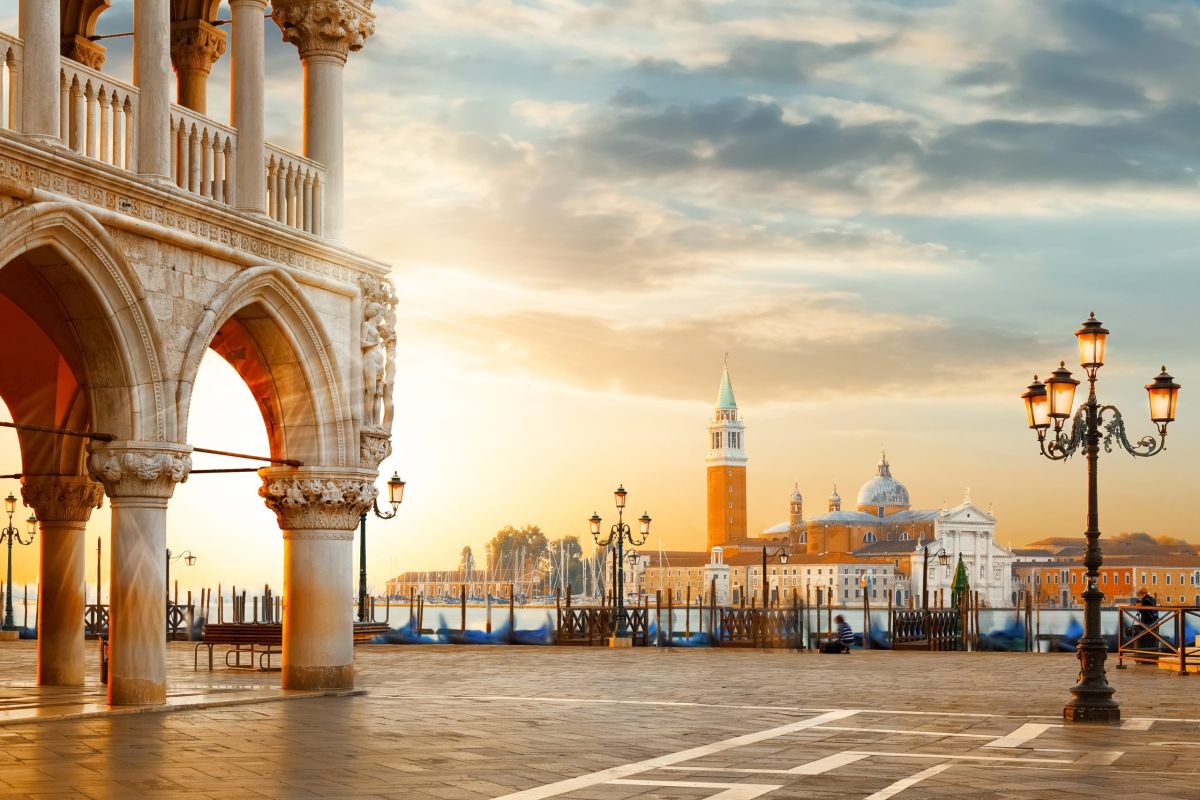
Modena is renowned worldwide for the famous people – Enzo Ferrari and Luciano Pavarotti above all – who were born and lived here, and for some of its gastronomical products. The city is the capital of the so-called “Motor Valley”: actually, the factories of the famous Italian sports car makers Ferrari, De Tomaso, Lamborghini and Maserati are located here.
The city of Modena hosts little jewels of art, such as the Romanesque Cathedral, wholly constructed with white marble and located in the heart of Modena, in Piazza Grande. The Piazza with the Cathedral and the Ghirlandina Tower is one of the 48 Italian sites on the UNESCO World Heritage List. The Ghirlandina, the bell tower rising majestically over the rooftops, derives from its marble balustrades around the steeple, suggesting the lightness of garlands.
In Maranello, you may visit Museo Ferrari, not just a collection of the past but an extraordinary experience of the world of Ferrari and sports car racing! How exciting to see the most beautiful cars in the world, exceptional artworks made by modern mechanic artisan masters.
Afterwards, you will move to the estate of a Balsamic Vinegar of Modena Producer, to delight in the unique, enticing taste of traditional balsamic vinegar. Balsamic Vinegar of Modena is obtained from partially fermented, cooked and concentrated grape must. The grapes come exclusively from the area’s vines, and the most critical processing phase is refinement inside containers of fine wood, such as oak, chestnut, oak, mulberry and juniper. Want to know more about this unique delicacy? Read the article in our BLOG.
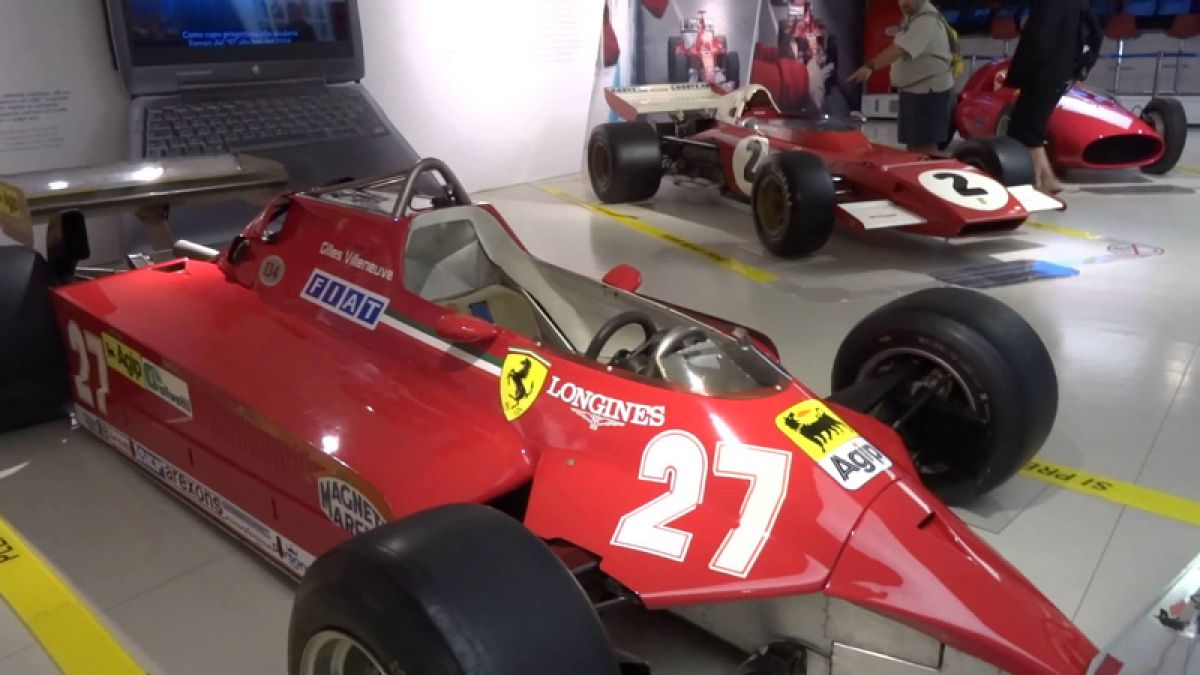
Benvenuti in Italia, welcome to the “unique” Venice, the “city on the lagoon”!
You will be astonished by its beauty and charm!
You will start your visit with Piazza San Marco (St. Mark’s Square) and the Basilica interior, a 900-year-old marvel of architecture! The church is unique in Italy for its golden Byzantine and Medieval mosaics, intricate stone and marble traceries and exuberant Middle Eastern domes. Near St. Mark’s Basilica is Palazzo Ducale, the most impressive secular building in Venice and once the official residence of the supreme authority of Venice, the “Doge”. A masterpiece of Gothic architecture, the Doge’s Palace is an impressive structure composed of layers of building elements and ornamentation, from its 14th and 15th-century original foundations to the significant Renaissance and opulent Mannerist adjunctions.
Then, you may visit Santa Maria Gloriosa dei Frari (Saint Mary’s of Friars), striking for its colossal size and the quality of its works of art, including masterpieces by Titian, Giovanni Bellini and Donatello, and several splendid tombs. Also, you may explore the streets and savour everyday life in an intricate maze of ancient narrow alleyways, lively squares with magnificent buildings and meandering canals, and finally, walk on the Rialto Bridge, Venice’s busy “heart”. Last but not least, you will enjoy a Gondola ride on the city’s canals: a jump back in time when Venetians moved only on the water.
At lunch, you may savour Venice’s finger food, the famous “cicheti”. There is tremendous variety, and options include anything from simple cheese or salami to almost any kind of seafood, fried and grilled vegetables, sweet and sour sardines, creamy codfish and much more!
Rich in traditions, Venice offers a wide selection of unique artisan products. In the city of the Italian carnival, the typical Venetian masks are a must. The cost of the original ones is relatively high, but it is really worth it! Also, don’t miss an authentic Murano glass object: each product is made and painted by hand, but be sure you buy an original product from Murano, guaranteed by a label or a signature (and the seller), not a Chinese copy!
Finally, at dinner, you will be delighted by the flavours of the regional cuisine of Veneto, boasting delicious recipes such as “Sarde in saor” (marinated sardines), Risotto with seafood, or the typical “Baccala’ mantecato” to finish with a fantastic “Bussolà”, the ring-shaped and cinnamon-flavoured cake! (read more about Venetian cuisine in our BLOG).
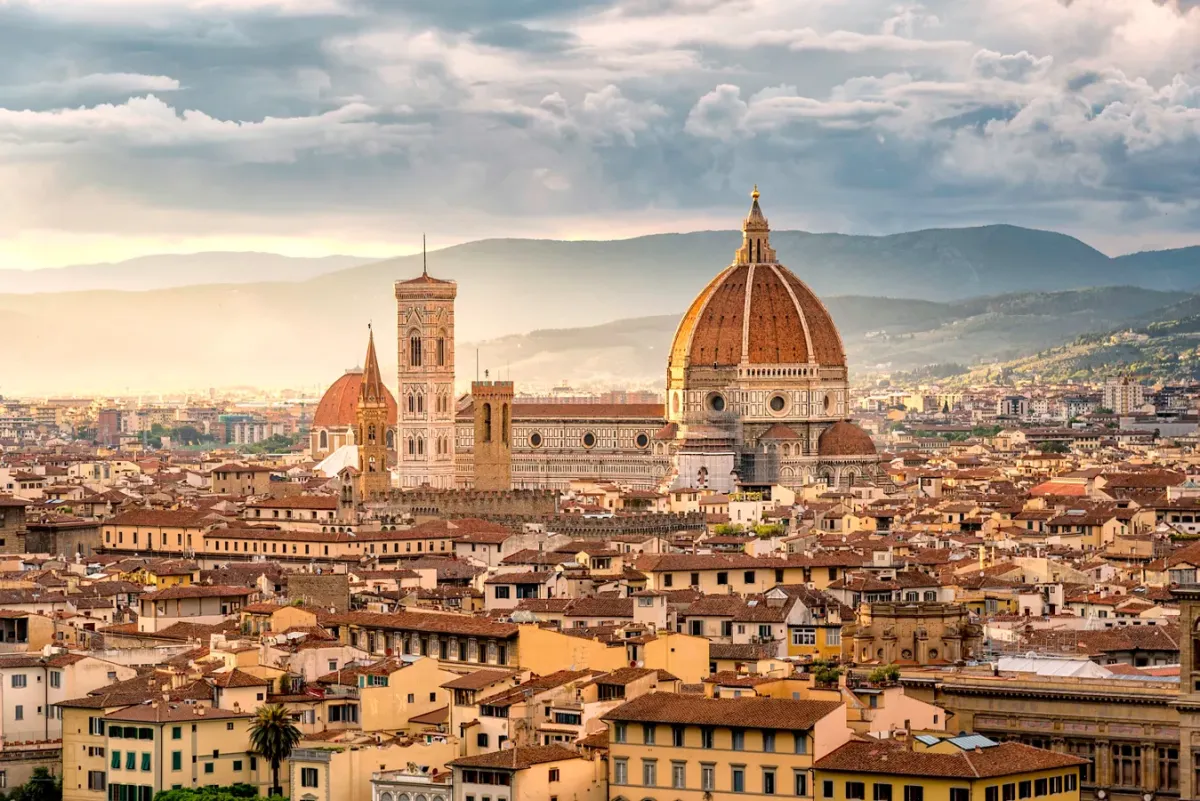
Pisa is famous worldwide for its “Torre Pendente” (Leaning Tower), but its wonderful square, Piazza dei Miracoli, set over an ample greenfield, hosts three other whiter-than-white masterpieces of exquisite Medieval art: the Cathedral, the Baptristy and the “Camposanto” (Graveyard). They are so unique that their creation originated a new style, “Pisan Romanesque”.
This area was chosen to construct the Duomo of Santa Maria Assunta strictly for its centrality; founded in 1064, it was intended to celebrate the grandeur of Pisa during the Marine Republic’s epoch of power. “The temple of marble white as the snow”; that’s how the structure is described on the gravestone of its architect, Buscheto di Giovanni Giudice. Consisting of five naves with its transept divided into three naves, it is surmounted by a splendid dome encircled by a loggia. The Duomo’s façade and exterior lateral sections feature elaborate decoration in marble (which can also be seen on its interior), mosaics, and bronze.
In front of the Cathedral stands the Baptistry, also in a particular version of the Romanesque style. Initiated in 1152 by Diotisalvi, the Baptistry was finally completed in the 14th century; Gothic elements were added then. Of cylindrical form and circled by arcades of columns, this structure in white marble even boasts impressive acoustics.
The Camposanto closes the northern end of the complex’s piazza. This monumental cemetery, begun in 1278, is bordered by a marble fence and houses a cloister at its centre. Unfortunately, most frescoes that once coloured its walls were destroyed in a fire in 1944 during the battle for Pisa.
Ultimately, the true symbol of Pisa is the Campanile, the Leaning Tower, which completes the image of this city. Because of land sinkage beneath it, the Tower stands at a significant incline. Its construction started in 1173, but the Tower was not completed until the second half of the 1300s. In cylindrical form, the blind arcades of its lower part mutate into six floors of loggias, repeating motifs from the Duomo. Inside, a spiral staircase of 294 steps leads to the heights of one of the most famous towers in the world, where the lovely belfry and a spectacular view of the surrounding landscape await.
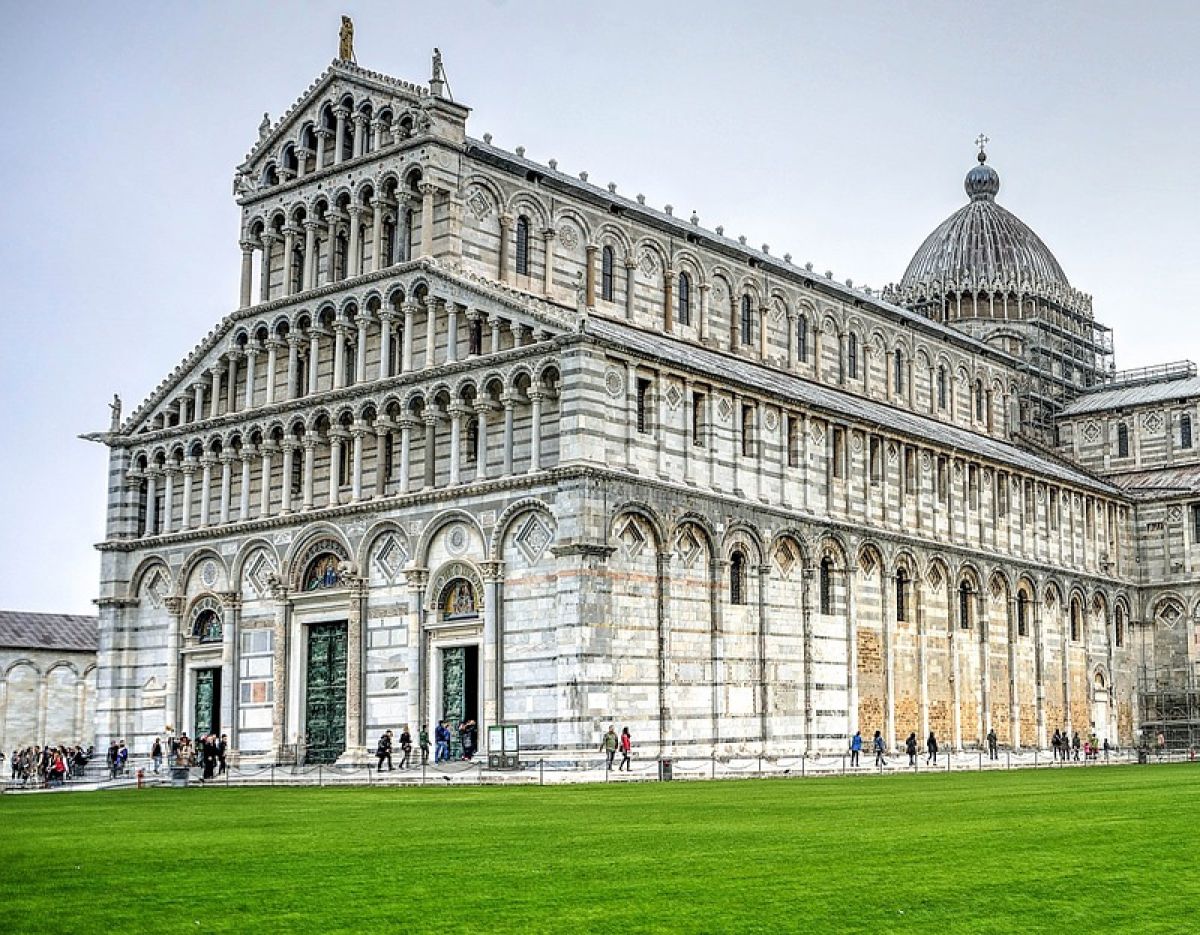
In Siena, the city of the Palio, you will walk on the famous Piazza del Campo, the concave square where horses run twice a year in a dangerous race that symbolizes the city’s freedom. On the days of the Palio, the whole town goes crazy; read about it in our BLOG.
Indeed, you will not forget the colour of frontages and roofs, the renowned colour “Sienna”, a pigment first produced during the Renaissance, that makes the city lovely and warm. And don’t forget to taste the Senese sweets: “cantucci” (biscuits with toasted almonds), “ricciarelli” (soft biscuits with icing sugar), “panforte” (cake with fruit nuts and spices) and “cavallucci” (biscuits with honey, walnut, candied fruits and spices. Travellers who love dessert will be delighted!
In the afternoon, you will stroll with your head upwards along the streets of one of the most beautiful cities in Tuscany, San Gimignano, also known as the “Medieval Manhattan”, thanks to its old and impressive 14 towers that dominate the town skyline. Originally, the towers were 72, and they were built by patrician families, probably to demonstrate their wealth and power. Seven of San Gimignano’s towers are around Piazza del Duomo; the tallest one is Torre Grossa, 54 meters high, dating back to 1298.
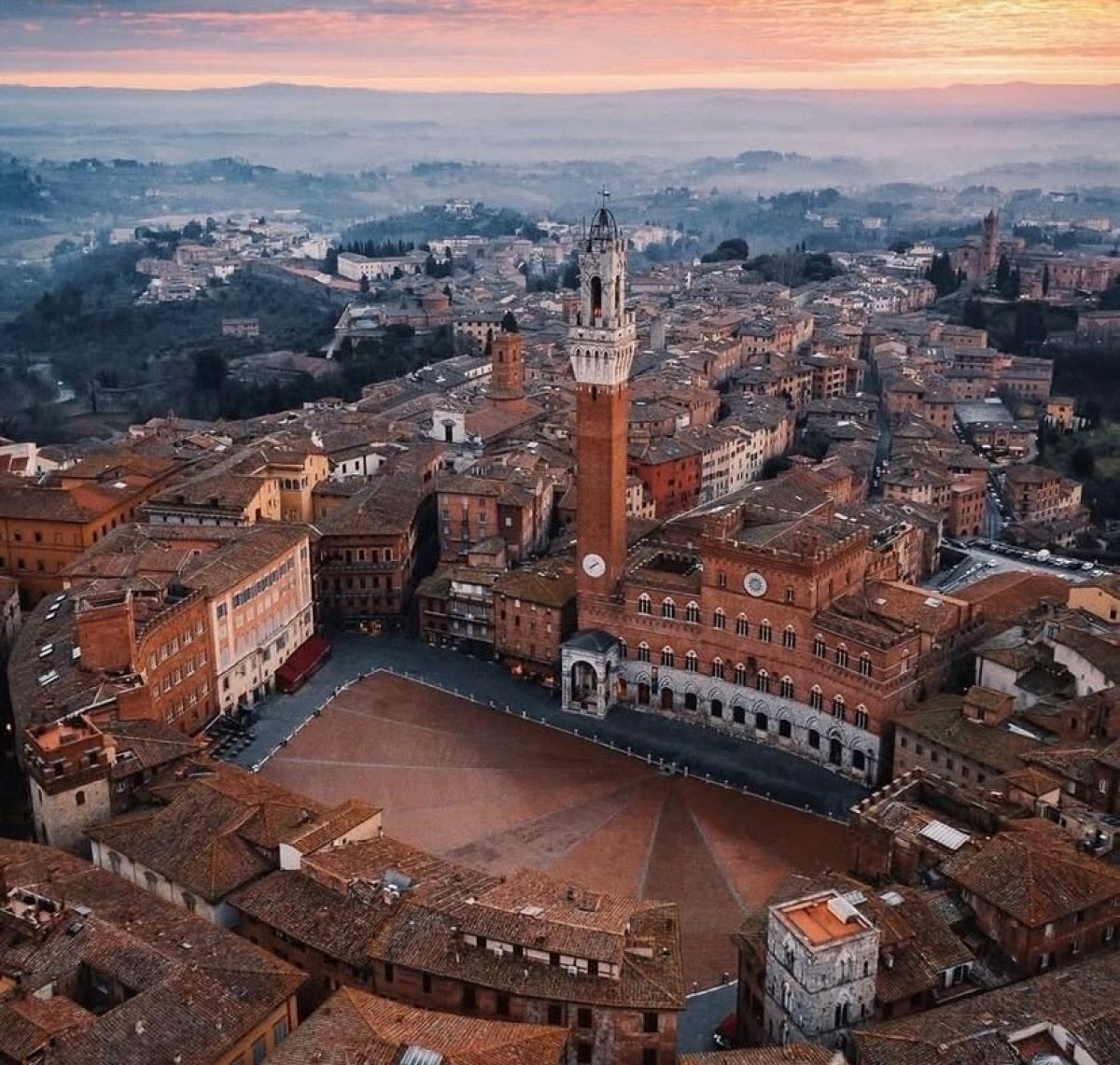
Val d’Orcia is one of the most fascinating places in Italy, included by UNESCO in the list of World Heritage Sites. Its landscape is a part of the agricultural hinterland of Siena, redrawn and developed when it was integrated into the city-state’s territory in the 14th and 15th centuries to reflect an idealized model of good governance and create an aesthetically pleasing picture. The landscape’s distinctive aesthetics, flat chalk plains with almost conical hills and fortified settlements on top, inspired many artists. Their images have come to exemplify the beauty of well-managed Renaissance agricultural landscapes.
In Montepulciano, our friend Francesca will lead you to discover this beautiful town full of stories, legends and thousand flavours, introducing you to the excellent products of this unique land: olive oil, pecorino cheese and Vino Nobile di Montepulciano.
Then, you will get to Montalcino, one of the prettiest hill towns in Tuscany. Around the village, rows of olive trees, precious grapevines and yellow fields create an enchanting landscape. Here, you may visit a Brunello winery to taste the most famous Supertuscan wine, probably the best Italian red!
Finally, you will stop in Bagno Vignoni, a tiny and charming village where the main square is a pool 49 meters long and 29 wide. Several hot springs, whose therapeutic qualities have been renowned since antiquity, bubble up from its bottom! All this creates a pleasant sensation; leaving will be hard!
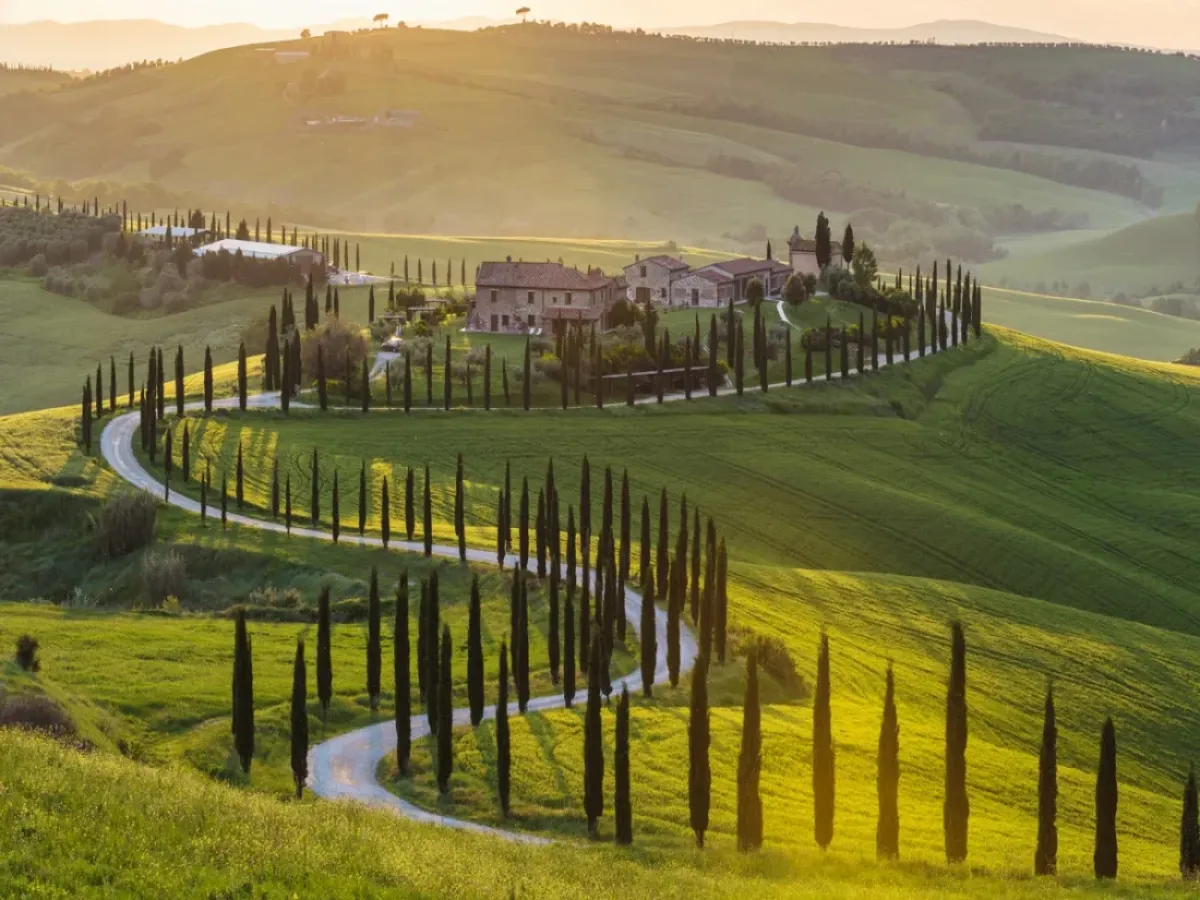
Here you are in Rome, where ancient history, excellent art and religious icons mix uniquely! Start from the 2,000-year-old Colosseum, the most famous amphitheatre in the world, and the Imperial Fora, the administrative and monumental centre of the Roman Empire. On the Palatine Hill, the majestic ruins of the Palaces of Augusto, Tiberius and Domiziano still dominate the Circus Maximus valley, 50-meter-high structures giving a unique view of the city.
Close to the Colosseum, inside the Church of San Pietro in Vincoli, you may see the famous Michelangelo sculpture of “Moses”. Supposedly, Michelangelo, admiring his Moses, enraptured by the so realistic shapes of the imposing statue, was struck by a violent outburst of anger and exclaimed the famous phrase “Perchè non parli?” (Why don’t you speak!?)
From Piazza Venezia, you will head inside “Baroque” Rome, starting with the Pantheon, dedicated to worshipping every god (Pan-every Theon-divinity), now the memorial chapel of great Italian people of the past. After that, don’t miss the Church of St. Louis of the French, famous for the cycle of paintings of the great Caravaggio at the end of the 16th century. Then, Piazza Navona, the splendid oval area corresponding to the underground Domitianus’ Stadium, with the gorgeous Fountain of the Four Rivers by Lorenzo Bernini in the centre of the Piazza. And finally, Fontana di Trevi, the city’s biggest and most famous fountain, a Rome icon renowned worldwide: here, statues of travertine marble stand over the cliff and the broad basin in an epic representation of the Kingdom of the Oceans.
At the end of the day, sit down at a local “trattoria” or “fiaschetteria“, the typical home-style restaurant, to taste authentic Roman cuisine in a popular and cheerful atmosphere (for an overview of Roman cuisine, see our BLOG).
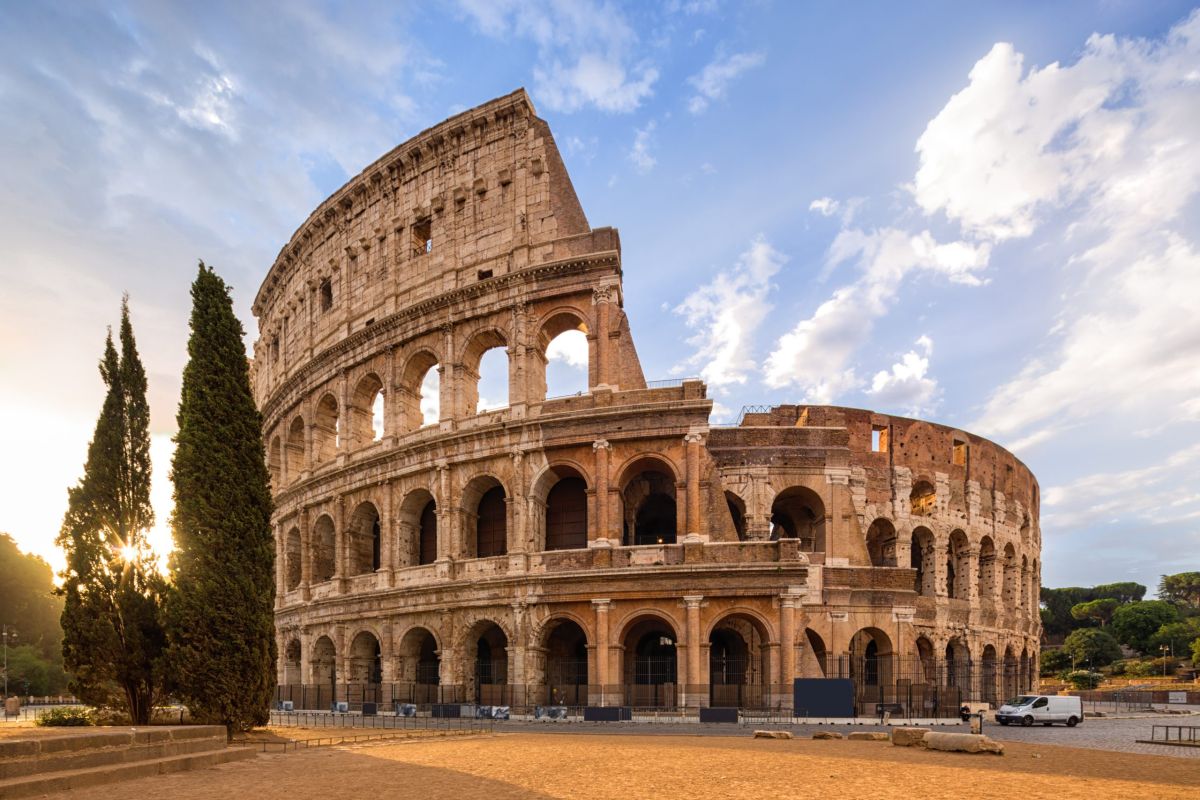
On the other side of River Tevere, Vatican Hill is the home of the tiny state of Vatican City. The immense St. Peter’s Basilica dominates the extraordinary Piazza framed by the magnificent four-column-deep colonnades designed by Gian Lorenzo Bernini. The Basilica is an extraordinary casket for some of the world’s most beautiful works of art, such as Michelangelo’s “La Pietà” and Bernini’s “Baldacchino”, along with works of the most important artists of the Renaissance, from Raphael to Canova.
Inside the Vatican Museums, you will be astonished by the exquisite and unique Sistine Chapel, the “Sancta Sanctorum” (“Holy among the Holiest” in Latin) of the Roman Catholic Church, where cardinals gather to elect the new Pope! The Sistine Chapel takes its name from Pope Sixtus IV della Rovere (pontiff from 1471 to 1484), who had the old Cappella Magna restored between 1477 and 1480. The decoration of the walls was executed by a team of painters, Pietro Perugino, Sandro Botticelli, Domenico Ghirlandaio and Cosimo Rosselli, assisted by their respective shops.
Julius II della Rovere (pontiff from 1503 to 1513), the nephew of Sixtus IV, decided to partly alter the decoration, entrusting the work in 1508 to Michelangelo Buonarroti, who painted the Ceiling and, on the upper part of the walls, the lunettes. The nine central panels show the Stories of Genesis, from the Creation to the Fall of Man to the Flood and the subsequent rebirth of humanity with the family of Noah. Again, towards the end of 1533, Clement VII de’ Medici (pontiff from 1523 to 1534) asked Michelangelo to paint the Last Judgement on the altar wall. How could he refuse? And, in fact, he did not, but painted his vision of the Judgement, with a powerful and furious Jesus Christ.
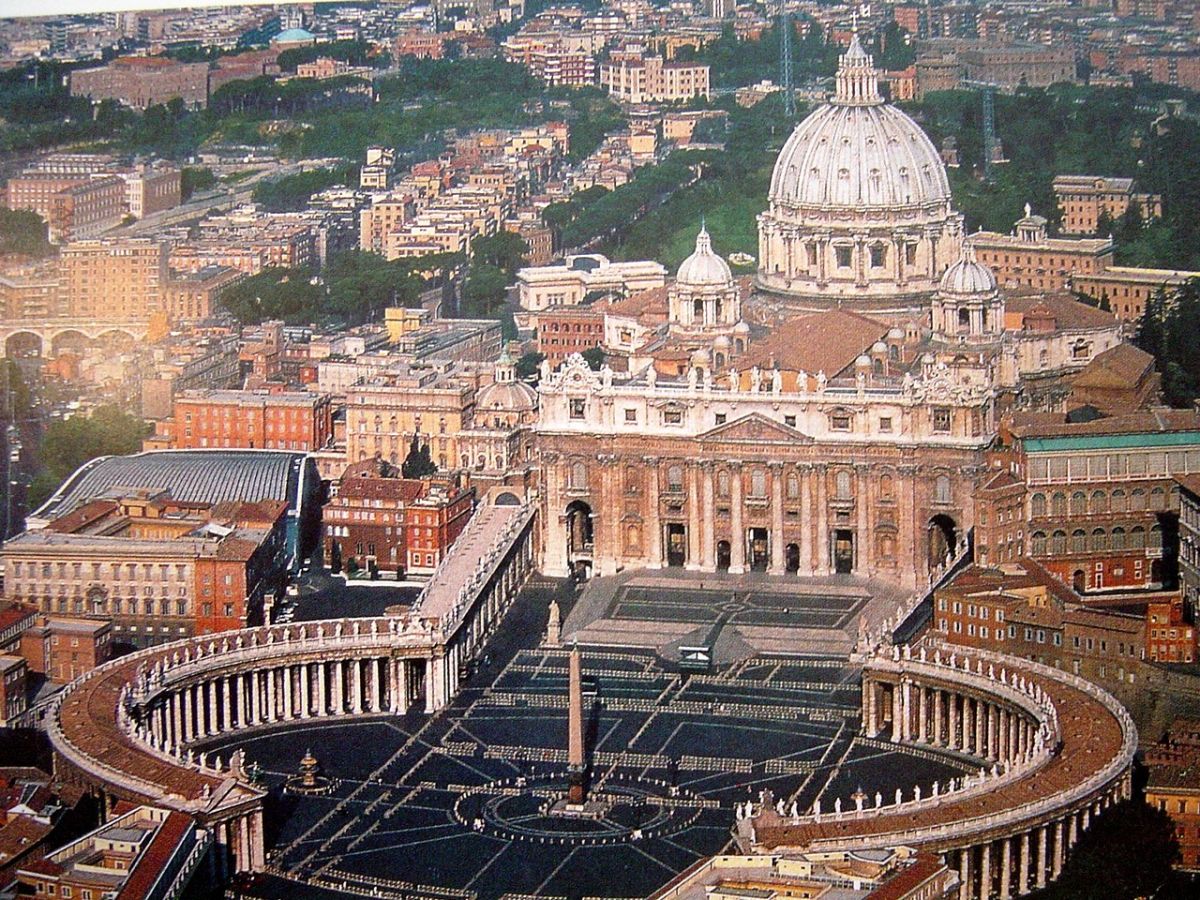
Welcome to the Amalfi Coast!
Costiera Amalfitana is Italy’s most scenic stretch of coastline, a landscape of pastel-coloured villages terraced into hillsides, steep panoramic roads, luxuriant gardens and enchanting vistas over turquoise waters and green mountains. Considered by UNESCO “an outstanding example of a Mediterranean landscape, with exceptional cultural and natural scenic values,” the coast has been a World Heritage Site since 1997. You may go from town to town at the discovery of Amalfi, Positano, and Ravello, three of the most beautiful villages in Southern Italy, world-famous for their charm and colourful architecture.
Amalfi typically has Mediterranean architecture with lanes and characteristic white houses piled one upon the other. In the Middle Ages, it was one of Italy’s four powerful maritime republics (with Venice, Pisa, and Genoa). All sea trade in the Mediterranean was once governed by the 12th century “Tavole Amalfitane”, one of the world’s oldest maritime codes. A must-see in Amalfi is the Duomo di Sant’Andrea, fronted by an intricately patterned façade, redone in the 19th century. Founded in the 9th century, the Cathedral’s subsequent alterations have spared its principal glory, the main portal’s 11th-century Byzantine bronze doors. Next to the church lies the Chiostro del Paradiso (1268), or Cloister of Paradise, whose serious Romanesque tone is animated by the Arab elements in its sinuous columns. To escape the bustle of Amalfi, let’s take the famous walk along the “Valle dei Mulini”, a steep-sided valley dotted with ruined watermills – “i mulini” – once used to make paper, an industry for which Amalfi was, and still is, famous.
Positano sits in a splendid panoramic position on one of the most beautiful stretches of coastline. Its enchanting town centre of delightful pastel-coloured houses surrounds the parish church of Santa Maria Assunta; its streets are lined with quaint, colourful shops, and its numerous beaches are world-famous.
Ravello is more elevated than the other pearls of the Amalfi Coast, boasting exceptional views of the coast and its marvellous villas and gardens. French novelist André Gide said they are “closer to the sky than the sea”. Here, you may visit Villa Rufolo, built in the 13th century, which hosted popes and kings, and Richard Wagner, who composed part of his opera Parsifal here in 1880. Views from its idyllic gardens are magnificent!
A trip to Cetara is an absolute must. The village is renowned for a particular gourmet speciality, “colatura di acciughe” (anchovy sauce), produced according to an ancient procedure for generations. Spaghetti with colatura di alici is the area’s typical recipe, a dish you will remember forever. Discover the secrets of the liquid gold of the Coast in the article in our BLOG.
At dinner, don’t miss Spaghetti with clams in olive oil and garlic sauce or Seafood Risotto with a glass of excellent Greco di Tufo white wine.
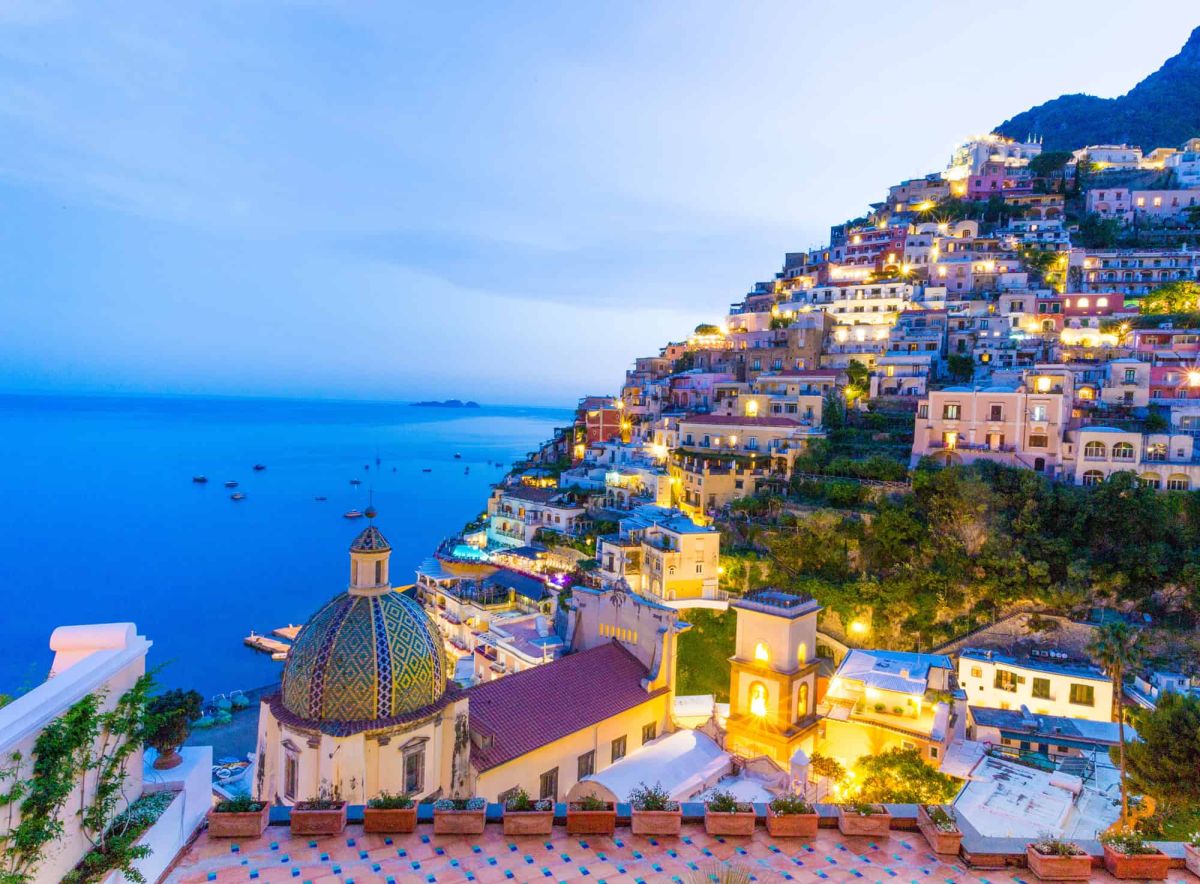
Pompeii, the Roman city excavated from the ashes of Vesuvius, has been a UNESCO World Heritage Site since 1997!
In 62 AD, the city was partially destroyed by an earthquake. As its reconstruction was still ongoing, on August 24, 79 AD, the eruption of Vesuvius covered the city and its suburban villas with a thick layer of stones, ashes and lapilli (thick, glassy lava). On the other hand, Herculaneum disappeared beneath a flood of volcanic mud.
The ruins of the ancient Roman cities offer an unparalleled window into the quotidian life of classical antiquity. Here you can understand how the Romans of the 1st century AD lived: from brothels and lavatories to posh dining rooms and bathing establishments, including modern spas, health clubs and gyms. The eruption of Mount Vesuvius destroyed the town in 79 AD, and the debris ejected by the volcano covered more than 3,000 people from the volcano.
Due to its healthy climate and pleasant scenery, Pompeii was a holiday resort for wealthy Romans. It is now famous for its civic buildings lining the streets, which are still intact today. The Surgeon’s House, the House of the Faun and the House of Chaste Lovers are exceptional examples of the epoch’s architecture. Another unique building is the House of Mysteries, deriving its name from the murals depicting the Dionysian cult’s initiation rites (i.e., the mysteries).
A peculiar characteristic of Pompeii is the florid graffiti covering the walls in just about every building; when the volcanic eruption happened, Pompeii was set to carry out elections in the days ahead – hence the writings and ideograms, which feature both political and sexual content.
The tour is over, but the memories of a fantastic journey will accompany you for a lifetime!
See more about your destinations on our YouTube channel.
Arrivederci for another tour with VITOR, Visit Italy on the Road.
